The MGA With An Attitude
MGA 1600-MK-II in Australia - CKD-102M
This article written by Thomas Aczel in Australia
The MGA 1600 Mk II in Australia
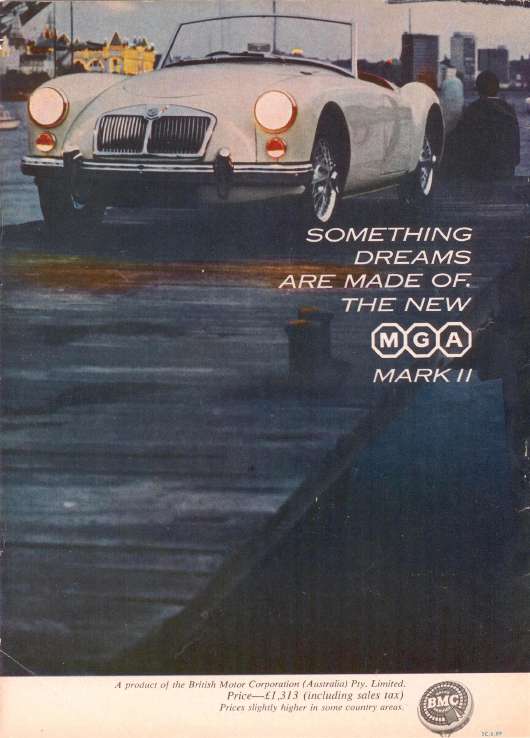
 Ad from back cover of October 1962 edition of Sports Car World Ad from back cover of October 1962 edition of Sports Car World
 2011 marks the 50th year since the introduction of the final development of the MGA line, the 1600 Mk II. (Oh dear, how fast the major part of my life has passed!!) 2011 marks the 50th year since the introduction of the final development of the MGA line, the 1600 Mk II. (Oh dear, how fast the major part of my life has passed!!)
The 1600 Mk II was introduced in the UK in March of 1961.
The MGA had been assembled in Australia from October 1957, not at the main BMC (Australia) plant in Joynton Avenue, Zetland, Sydney, but at the “Pressed Metal Corporation” facility in Cosgrove Road, Enfield, also in Sydney, starting with the 1500 models and followed by the subsequent MGA1600 and 1600Mk II versions. (Only roadsters were locally assembled, the coupes and Twin Cams all being imported CBU: completely built up.)
 Ultimately somewhere over two thousand MGA roadsters were locally assembled. By 1961 however, MGA sales were tapering off quite dramatically, and BMC (Australia) had begun to stockpile excess CKD MGA kits that were held over for later assembly. Hence instead of the previous two to three months taken between the despatches of the MGA components from the UK to completion of assembly of the car locally, there was now a delay of up to thirteen months between despatch and completion. Ultimately somewhere over two thousand MGA roadsters were locally assembled. By 1961 however, MGA sales were tapering off quite dramatically, and BMC (Australia) had begun to stockpile excess CKD MGA kits that were held over for later assembly. Hence instead of the previous two to three months taken between the despatches of the MGA components from the UK to completion of assembly of the car locally, there was now a delay of up to thirteen months between despatch and completion.
 The packing of the first batch of Australia-bound Mk II chassis was in fact commenced on the 5th of April 1961, virtually a matter of days after the model’s introduction in the UK and despatched for shipping to Australia on the 5th of May. (Australia in fact received the first Mk II engine, 16GCUL101). Due to a number of factors, the final MGA 1600 was however not assembled locally till February 1962. As a result, the first Australian 1600 Mk II was not assembled till late in February 1962, almost 12 months after its UK release. Australian production of the MGA ceased in July, or August 1962. Only a total of one hundred and forty eight 1600 Mk II models were ever locally assembled. The packing of the first batch of Australia-bound Mk II chassis was in fact commenced on the 5th of April 1961, virtually a matter of days after the model’s introduction in the UK and despatched for shipping to Australia on the 5th of May. (Australia in fact received the first Mk II engine, 16GCUL101). Due to a number of factors, the final MGA 1600 was however not assembled locally till February 1962. As a result, the first Australian 1600 Mk II was not assembled till late in February 1962, almost 12 months after its UK release. Australian production of the MGA ceased in July, or August 1962. Only a total of one hundred and forty eight 1600 Mk II models were ever locally assembled.
 Sports Car World magazine carried its first road test of an Australian built 1600 Mk II in August 1962. By the October 1962 edition of Sports Car World however, (which incidentally carried the above advertisement on its back cover), there was extensive coverage of the newly announced MGB in the magazine. Sports Car World magazine carried its first road test of an Australian built 1600 Mk II in August 1962. By the October 1962 edition of Sports Car World however, (which incidentally carried the above advertisement on its back cover), there was extensive coverage of the newly announced MGB in the magazine.
The 1600 Mk II alterations.
 By the time of the introduction of the Mk II, development of the MGB was well advanced, with a number of pre-production examples already assembled and undergoing trials in the UK. Nonetheless a number of modifications both mechanical and cosmetic were introduced with this final version of the MGA. Some but not all of the changes introduced in the Abingdon built MGA 1600 Mk II cars were incorporated in their Australian counterparts. A number of these changes were controversial (the altered external appearances were not universally admired), but all the changes were in hindsight worthwhile developments of what had been thus far the most successful MG model by a considerable margin, with over 100,000 examples being ultimately built worldwide. By the time of the introduction of the Mk II, development of the MGB was well advanced, with a number of pre-production examples already assembled and undergoing trials in the UK. Nonetheless a number of modifications both mechanical and cosmetic were introduced with this final version of the MGA. Some but not all of the changes introduced in the Abingdon built MGA 1600 Mk II cars were incorporated in their Australian counterparts. A number of these changes were controversial (the altered external appearances were not universally admired), but all the changes were in hindsight worthwhile developments of what had been thus far the most successful MG model by a considerable margin, with over 100,000 examples being ultimately built worldwide.
Mechanical changes.
Engine:
 The engine received a minor (34 cc) capacity enlargement by the bore size being taken out from 75.4mm to 76.2mm. This may seem an odd and almost pointless exercise, but the previous 1588cc displacement had been unique to MG (both twin cam and OHV), and the 1622cc size was to become the standard BMC B-series engine capacity with bore and stroke in imperial terms becoming 3” and 3.5”. It was obviously a troublesome, and presumably expensive exercise to do engine runs in a different bore size to that fitted to other vehicles in the BMC product range. Unfortunately for MG however this lifted the MGA out of the 1600cc class for racing and into the 2 litre category, where they clearly would struggle to compete. The engine received a minor (34 cc) capacity enlargement by the bore size being taken out from 75.4mm to 76.2mm. This may seem an odd and almost pointless exercise, but the previous 1588cc displacement had been unique to MG (both twin cam and OHV), and the 1622cc size was to become the standard BMC B-series engine capacity with bore and stroke in imperial terms becoming 3” and 3.5”. It was obviously a troublesome, and presumably expensive exercise to do engine runs in a different bore size to that fitted to other vehicles in the BMC product range. Unfortunately for MG however this lifted the MGA out of the 1600cc class for racing and into the 2 litre category, where they clearly would struggle to compete.
 Other internal engine changes however were significant and advantageous. At the bottom end, the crankshaft was now stronger with slightly narrower centre bearing “cradle”. The flywheel was also modified, being lightened by about 8.5 lbs. Other internal engine changes however were significant and advantageous. At the bottom end, the crankshaft was now stronger with slightly narrower centre bearing “cradle”. The flywheel was also modified, being lightened by about 8.5 lbs.
 (The engine components were still fully imported from the UK and assembled locally, even though the B-Series engine was being fully manufactured at the Zetland plant. The Australian 1500cc and 1622cc 4 cylinder engines used for mainstream locally manufactured medium and large sized BMC saloons were however constructed without the beefed-up bottom end.) (The engine components were still fully imported from the UK and assembled locally, even though the B-Series engine was being fully manufactured at the Zetland plant. The Australian 1500cc and 1622cc 4 cylinder engines used for mainstream locally manufactured medium and large sized BMC saloons were however constructed without the beefed-up bottom end.)
See also 1) and 2) below
 The cylinder head (now marked in the casting with a “16” as opposed to “15”) featured larger valves, revised combustion chambers with less shrouding of the valves, and improved porting. The compression ratio was raised to 8.9:1 from 8.3:1, though with our poorer fuels in Australia, the 8.3:1 ratio was retained here. European and North American cars now boasted 90 Hp and 97 lb ft of torque. (Our low compression engines managed 84.6 Hp and 98lb ft of torque, still a handy increase from the 1600’s 78 Hp and 87 lb ft). The cylinder head (now marked in the casting with a “16” as opposed to “15”) featured larger valves, revised combustion chambers with less shrouding of the valves, and improved porting. The compression ratio was raised to 8.9:1 from 8.3:1, though with our poorer fuels in Australia, the 8.3:1 ratio was retained here. European and North American cars now boasted 90 Hp and 97 lb ft of torque. (Our low compression engines managed 84.6 Hp and 98lb ft of torque, still a handy increase from the 1600’s 78 Hp and 87 lb ft).
 The high compression 1622 engine in fact now produced virtually identical horsepower as the Twin Cam between 2,500rpm and 4,000rpm, and only above this level did the Twin Cam with its better breathing steadily rise in its output over its more basic (but much less demanding) sibling. Torque too was similar between 2,500 rpm, beyond which the Twin Cam again clearly demonstrated its more sophisticated cylinder head’s benefits. The high compression 1622 engine in fact now produced virtually identical horsepower as the Twin Cam between 2,500rpm and 4,000rpm, and only above this level did the Twin Cam with its better breathing steadily rise in its output over its more basic (but much less demanding) sibling. Torque too was similar between 2,500 rpm, beyond which the Twin Cam again clearly demonstrated its more sophisticated cylinder head’s benefits.
Oil Cooler:
 A welcome addition in our climate to the final eighty-eight Mk II cars was the fitting of a 10-row engine oil cooler ahead of the radiator, now supplied as standard equipment. A welcome addition in our climate to the final eighty-eight Mk II cars was the fitting of a 10-row engine oil cooler ahead of the radiator, now supplied as standard equipment.
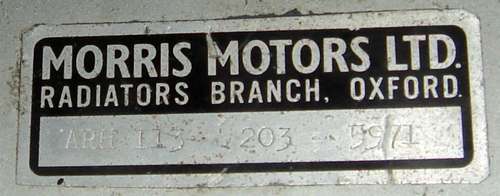
Not often seen these days is the label originally applied to the top of the factory supplied oil cooler. (ARH 113-203-5971 refers to the “drawing number”, “issue number” and “serial number”).
Differential:
 The final drive ratio was raised from 4.3:1 (17.0 mph/1000 rpm) to 4.1:1 (17.9 mph/1000 rpm), making for somewhat more restful cruising, though slightly blunting the additional acceleration potential of the new more powerful engine. The final drive ratio was raised from 4.3:1 (17.0 mph/1000 rpm) to 4.1:1 (17.9 mph/1000 rpm), making for somewhat more restful cruising, though slightly blunting the additional acceleration potential of the new more powerful engine.
Cosmetic changes.
Grille:
 Generally felt to be less attractive than its predecessor, the Mark II grille now featured recessed vertical grille bars instead of the curved bars of the earlier grille which followed the overall curved body profile. Less attractive or not, the later grille probably traps the oncoming air flow better than the earlier style, a definite benefit in a car that tends to have hot running issues in certain conditions. Generally felt to be less attractive than its predecessor, the Mark II grille now featured recessed vertical grille bars instead of the curved bars of the earlier grille which followed the overall curved body profile. Less attractive or not, the later grille probably traps the oncoming air flow better than the earlier style, a definite benefit in a car that tends to have hot running issues in certain conditions.
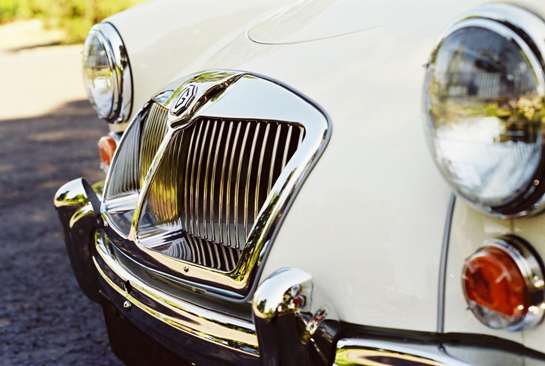
Tail-lights:
 The previous stacked tail light cluster on the trailing side of the rear guards were replaced by horizontally orientated “Morris Mini” tail lights inboard of the rear guards. Whether this was “a change for the sake of a change” to indicate a newer model, or because Lucas was discontinuing the large series production of the now outmoded individual round lens lights is not clear. Most however prefer the style of the earlier lights. (I realize that I’m in the minority here, but to me the 1600 rear lights always look like a pair of jukeboxes stacked on the guards, and I personally prefer the way the Mk II light clusters leave the rear guards’ lovely curves unadulterated). The previous stacked tail light cluster on the trailing side of the rear guards were replaced by horizontally orientated “Morris Mini” tail lights inboard of the rear guards. Whether this was “a change for the sake of a change” to indicate a newer model, or because Lucas was discontinuing the large series production of the now outmoded individual round lens lights is not clear. Most however prefer the style of the earlier lights. (I realize that I’m in the minority here, but to me the 1600 rear lights always look like a pair of jukeboxes stacked on the guards, and I personally prefer the way the Mk II light clusters leave the rear guards’ lovely curves unadulterated).
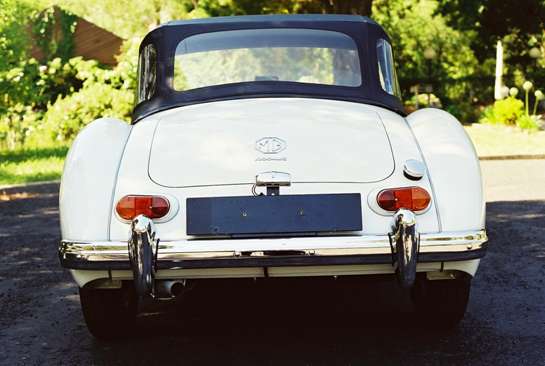
As incidentally can be seen in the above illustration, all of the Australian assembled MGA cars took the wiring for the number plate light around the rear valence panel, rather than (more neatly) through it as in their UK counterparts.
Dashboard:
 The Abingdon built Mk II featured a vinyl covered dashboard and vinyl covered scuttle top (to reduce the at times annoying reflections in the windscreen) and chrome embellishments around the horn button and dashboard lower edge, like the Coupe and Twin Cam. The Abingdon built Mk II featured a vinyl covered dashboard and vinyl covered scuttle top (to reduce the at times annoying reflections in the windscreen) and chrome embellishments around the horn button and dashboard lower edge, like the Coupe and Twin Cam.
 The Australian Mk II however, while carrying the chrome dashboard highlights of their UK equivalents, retained a painted dashboard and scuttle top. The Australian Mk II however, while carrying the chrome dashboard highlights of their UK equivalents, retained a painted dashboard and scuttle top.
 The reason for the omission of the dashboard and scuttle vinyl coverings in the Australian MGA 1600 Mk II is no longer clear. Two suggestions have been made. The first is that with the delay in the model’s introduction in Australia, and a production run likely to only be for about six months, it did not appear worthwhile introducing the changes. (The trim on the Australian assembled MGA was locally sourced). The reason for the omission of the dashboard and scuttle vinyl coverings in the Australian MGA 1600 Mk II is no longer clear. Two suggestions have been made. The first is that with the delay in the model’s introduction in Australia, and a production run likely to only be for about six months, it did not appear worthwhile introducing the changes. (The trim on the Australian assembled MGA was locally sourced).
 A second possible explanation is offered by John Lindsay, whose long involvement with BMC (Australia) allows much insight into the production arrangements of the time: A second possible explanation is offered by John Lindsay, whose long involvement with BMC (Australia) allows much insight into the production arrangements of the time:
“it was probably just a breakdown in communication, either intentional or not. Remember that the body, paint and trim was only carried out under contract by Pressed Metal on behalf of BMC at Zetland, so any build instructions would have been received by BMC and then relayed to Pressed Metal.
 In 1961 and 1962 the production planning people were up to their eyeballs with plant expansions, new models and new people, so having to provide support to Pressed Metal would have been well down the list of priorities and the simple instruction of slapping on a bit of extra trim would more than likely just slipped off the radar”. In 1961 and 1962 the production planning people were up to their eyeballs with plant expansions, new models and new people, so having to provide support to Pressed Metal would have been well down the list of priorities and the simple instruction of slapping on a bit of extra trim would more than likely just slipped off the radar”.
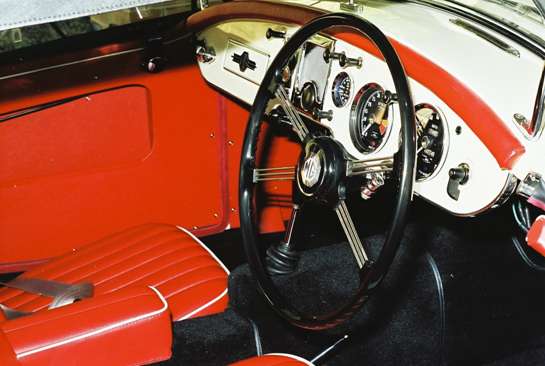
Note that Australian MGA had the seat facings trimmed in vinyl rather than in the leather of their UK counterparts, a choice probably driven by concerns regarding the durability of leather in the harsh Australian sun as much as cost.
Mostly ignored at the time, but appreciated today was the inclusion in the Mk II of seat belt mounting points.
Other Local Anomalies;
1) Model Designation:
 In the UK, the MGA 1600 Mk II was coded “GHN2”. The same model MGA was coded “YGHN3” on its introduction in Australia (Where “Y” in BMC parlance indicated Australian assembly). Remarkably, and completely inexplicably, the following, and totally different MGB was also coded model type “YGHN3”! In the UK, the MGA 1600 Mk II was coded “GHN2”. The same model MGA was coded “YGHN3” on its introduction in Australia (Where “Y” in BMC parlance indicated Australian assembly). Remarkably, and completely inexplicably, the following, and totally different MGB was also coded model type “YGHN3”!
2) Makers’ Plate:
 The Australian assembled MGA cars had carried an MG- specific maker’ plate attached to the heater shelf, carrying the appropriate Nuffield (Australia) nomenclature. Following the eventual incorporation of Nuffield, Austin and Fisher and Ludlow into BMC (Australia), all Australian built vehicles were progressively fitted with BMC (Australia) plates. The MGA plates followed suit as stocks of the earlier plates were depleted. For the MGA this change over occurred during the run of the 1600 Mk II model. The Australian assembled MGA cars had carried an MG- specific maker’ plate attached to the heater shelf, carrying the appropriate Nuffield (Australia) nomenclature. Following the eventual incorporation of Nuffield, Austin and Fisher and Ludlow into BMC (Australia), all Australian built vehicles were progressively fitted with BMC (Australia) plates. The MGA plates followed suit as stocks of the earlier plates were depleted. For the MGA this change over occurred during the run of the 1600 Mk II model.
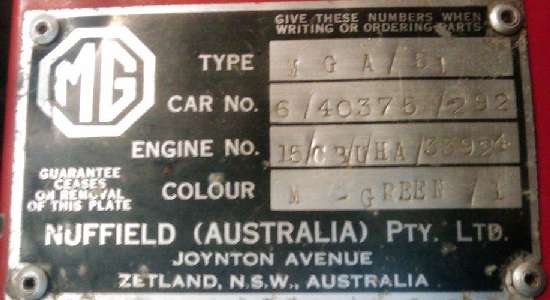
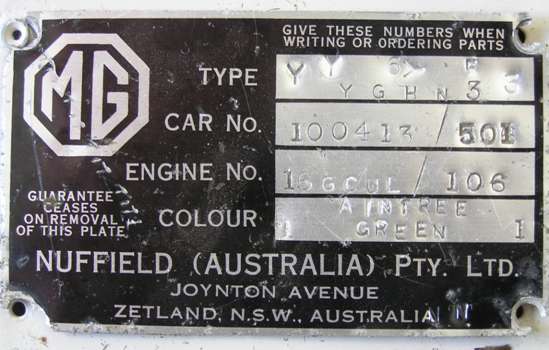
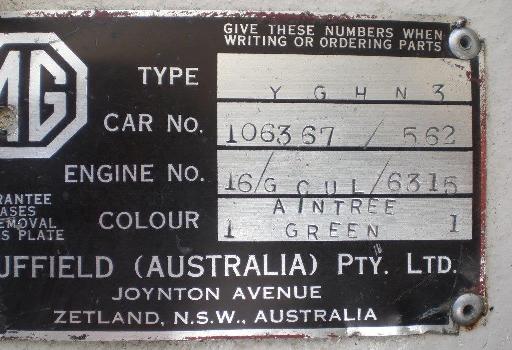
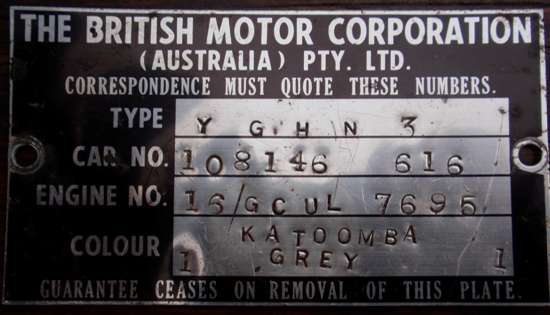
 So, in summary, the MGA 1600 Mk II seems to represent a final late expression of all that was great about the MGA, with a few enhancements to lift its performance a little above its still lovely predecessors; a delightful, undemanding, robust and very pretty sports car that required little specialist attention, yet could deliver pleasurable performance to anyone with the slightest interest in driving just for the fun of it. So, in summary, the MGA 1600 Mk II seems to represent a final late expression of all that was great about the MGA, with a few enhancements to lift its performance a little above its still lovely predecessors; a delightful, undemanding, robust and very pretty sports car that required little specialist attention, yet could deliver pleasurable performance to anyone with the slightest interest in driving just for the fun of it.
1) Additionally a 2433cc 6 cylinder B-Series “Blue Streak Six” was manufactured in 1962 for the larger Farina saloons in Australia. This engine was later considered for fitting to the MGC.
2) With the MGA, the engines, gearboxes, front and rear suspensions were all assembled at the BMC plant in Zetland and supplied to Pressed Metal Corporation in Enfield. The MGB was a different story as the BMC Zetland plant moved into front wheel drive production.
(My sincere thanks go to both Garry Kemm, and John Lindsay for their generous assistance with compiling this brief history of the Australian assembled model of the MGA 1600 Mk II).
|